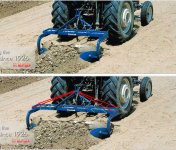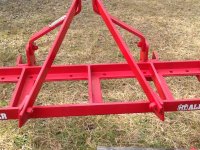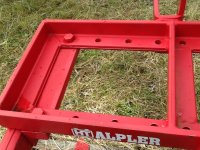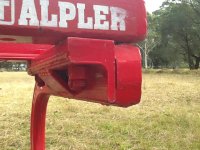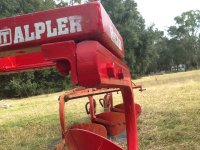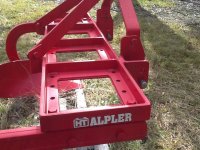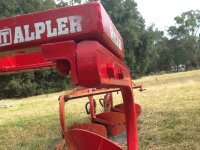OP
Gus Osmium
Member
How is this plough used? Here is a pic of the plough in use.
It is pretty versatile, the ploughs can be set to face/turn soil inwards or outwards with a range of spacing widths between. Setting the frame with a single plough on the very edge of the frame facing/turning outwards (one side only) is a really efficient way to dig a contour drain across the slope with the upturned sod forming a mound below the spoon drain, and you can even do this closely along a fence line.
I have heavy subsoils and need to form raised beds for my orchard rows for improved drainage, but the frame is a bit too narrow for that so I want to widen it by 250mm (10") at each end. This will enable me to form up wider beds more effectively and with the minimum number of passes. One pass down the midrow with both ploughs set to turn soil from my rear wheel track to the outside (on each side). Importantly for my heavier soils the wider frame will allow me to then re-set the width so tips of each plough are set on the outside width of my rear wheel track (still facing/turning soil outwards) so I can make a second pass directly down the same midrow to turn the soil and the same already turned sods outwards again without having to drive directly over the already turned sod or the planting bed. The result being an elevated, un-compacted planting bed and lowered wheel tracks in my midrow for improved drainage, onto which I can broadcast the same tall fescues and phalaris grasses (both of which tolerate heavy soils and wet feet), lucerne and sub clovers that collectively make up my pasture.
The plough is made for bed forming for row crops in cultivated soils as shown in the picture below, which I assume is why there is no cutting wheel in front of each plough like you find on many moldboard ploughs - but that is not what I use it for.
Thanks, Gus

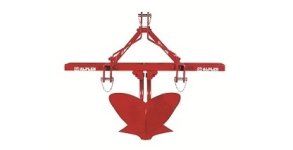
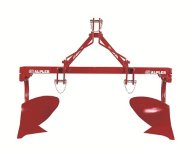
It is pretty versatile, the ploughs can be set to face/turn soil inwards or outwards with a range of spacing widths between. Setting the frame with a single plough on the very edge of the frame facing/turning outwards (one side only) is a really efficient way to dig a contour drain across the slope with the upturned sod forming a mound below the spoon drain, and you can even do this closely along a fence line.
I have heavy subsoils and need to form raised beds for my orchard rows for improved drainage, but the frame is a bit too narrow for that so I want to widen it by 250mm (10") at each end. This will enable me to form up wider beds more effectively and with the minimum number of passes. One pass down the midrow with both ploughs set to turn soil from my rear wheel track to the outside (on each side). Importantly for my heavier soils the wider frame will allow me to then re-set the width so tips of each plough are set on the outside width of my rear wheel track (still facing/turning soil outwards) so I can make a second pass directly down the same midrow to turn the soil and the same already turned sods outwards again without having to drive directly over the already turned sod or the planting bed. The result being an elevated, un-compacted planting bed and lowered wheel tracks in my midrow for improved drainage, onto which I can broadcast the same tall fescues and phalaris grasses (both of which tolerate heavy soils and wet feet), lucerne and sub clovers that collectively make up my pasture.
The plough is made for bed forming for row crops in cultivated soils as shown in the picture below, which I assume is why there is no cutting wheel in front of each plough like you find on many moldboard ploughs - but that is not what I use it for.
Thanks, Gus



Last edited:
